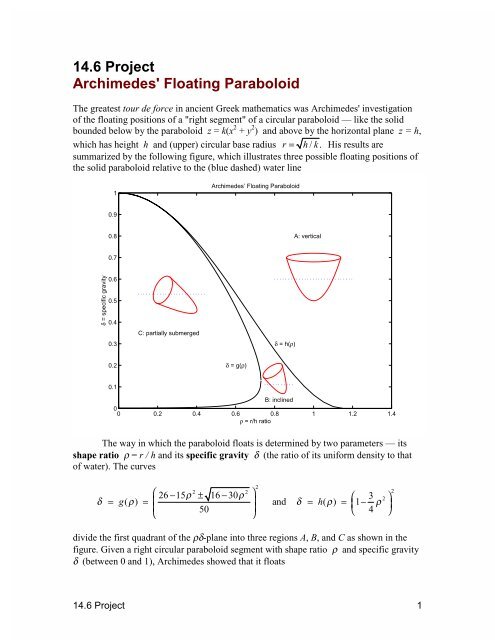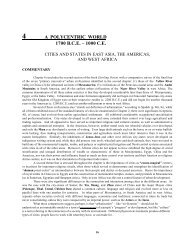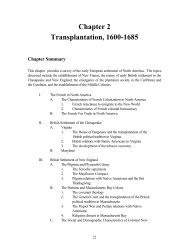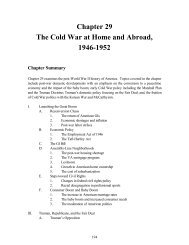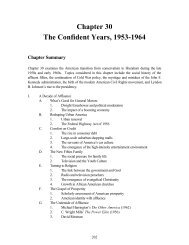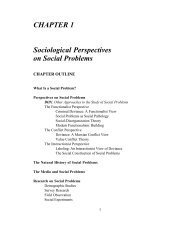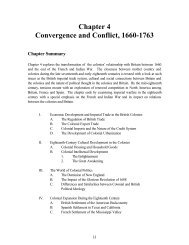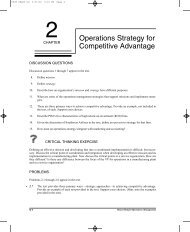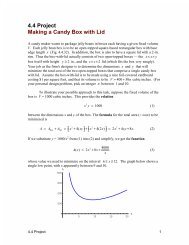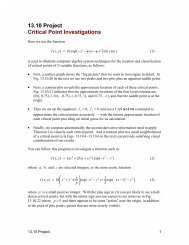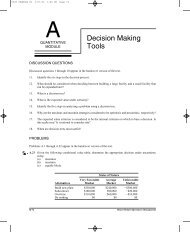14.6 Project Archimedes' Floating Paraboloid
14.6 Project Archimedes' Floating Paraboloid
14.6 Project Archimedes' Floating Paraboloid
You also want an ePaper? Increase the reach of your titles
YUMPU automatically turns print PDFs into web optimized ePapers that Google loves.
<strong>14.6</strong> <strong>Project</strong><br />
<strong>Archimedes'</strong> <strong>Floating</strong> <strong>Paraboloid</strong><br />
The greatest tour de force in ancient Greek mathematics was <strong>Archimedes'</strong> investigation<br />
of the floating positions of a "right segment" of a circular paraboloid — like the solid<br />
bounded below by the paraboloid z = k(x 2 + y 2 ) and above by the horizontal plane z = h,<br />
which has height h and (upper) circular base radius r = h/ k.<br />
His results are<br />
summarized by the following figure, which illustrates three possible floating positions of<br />
the solid paraboloid relative to the (blue dashed) water line<br />
δ = specific gravity<br />
1<br />
0.9<br />
0.8<br />
0.7<br />
0.6<br />
0.5<br />
0.4<br />
0.3<br />
0.2<br />
0.1<br />
C: partially submerged<br />
Archimedes’ <strong>Floating</strong> <strong>Paraboloid</strong><br />
δ = g(ρ)<br />
δ = h(ρ)<br />
A: vertical<br />
0<br />
0 0.2 0.4 0.6<br />
B: inclined<br />
0.8 1 1.2 1.4<br />
ρ = r/h ratio<br />
The way in which the paraboloid floats is determined by two parameters — its<br />
shape ratio ρ = r / h and its specific gravity δ (the ratio of its uniform density to that<br />
of water). The curves<br />
2<br />
26<br />
2<br />
15ρ 16<br />
2<br />
30ρ 3<br />
⎛ − ± − ⎞<br />
⎛ 2 ⎞<br />
δ = g( ρ) = ⎜ ⎟ and δ = h(<br />
ρ) = 1−<br />
ρ<br />
⎜ ⎜ ⎟<br />
50 ⎟<br />
⎝ ⎠<br />
⎝ 4 ⎠<br />
divide the first quadrant of the ρδ-plane into three regions A, B, and C as shown in the<br />
figure. Given a right circular paraboloid segment with shape ratio ρ and specific gravity<br />
δ (between 0 and 1), Archimedes showed that it floats<br />
<strong>14.6</strong> <strong>Project</strong> 1<br />
2
• in a vertical upright position if the point (ρ, δ) lies in region A,<br />
• in an inclined position with its base above water if the point (ρ, δ) lies in<br />
region B,<br />
• with its base partially submerged if the point (ρ, δ) lies in region C.<br />
Here are some preliminary exercises to check your understanding of the<br />
"classifying figure" above.<br />
Exercise 1<br />
above water.<br />
If ρ > 8/15 ≈ 0.73 then the paraboloid floats with its base entirely<br />
Exercise 2 If ρ > 4 / 3 ≈ 1.15 then the paraboloid floats in a vertical position.<br />
Exercise 3 If the paraboloid is made of cork with density δ = 0.25, then it floats with<br />
its base partially submerged if ρ < 0.70, in an inclined position with its base above water<br />
if 0.70 < ρ < 0.82, and in a vertical position if ρ > 0.82.<br />
Exercise 4 If the paraboloid has shape ratio ρ = 0.8, then it floats in an inclined<br />
position with its base above water if δ < 0.27, but in a vertical position if δ > 0.27.<br />
Exercise 5 If the paraboloid has shape ratio ρ = 0.7, then it floats in an inclined<br />
position with its base above water if δ < 0.06, with its base partially submerged if<br />
0.06 < δ < 0.26, and in a vertical position if δ > 0.26.<br />
The Inclined Position<br />
This is the most interesting case. The portion of the solid circular paraboloid that lies<br />
beneath the water line has the shape of an "oblique segment" of a paraboloid — one that<br />
is cut off from the original (vertical) paraboloid by a non-horizontal plane. The depth to<br />
which the floating paraboloid sinks in the water, as well as its angle of inclination from<br />
the vertical, are determined by <strong>Archimedes'</strong> law of buoyancy, which implies that<br />
• the weight of the water displaced by the segment beneath the water line equals the<br />
weight of the whole floating paraboloid, and<br />
• the two centroids — that of the whole floating paraboloid, and that of the segment<br />
beneath the water line — lie on the same vertical line (else gravity would cause<br />
the floating paraboloid to rotate one way or the other).<br />
An Oblique Segment of a <strong>Paraboloid</strong><br />
Consequently, the crux of <strong>Archimedes'</strong> analysis was his determination of the volume and<br />
centroid of an oblique segment of a paraboloid. For your own personal oblique segment<br />
to investigate, let T be the solid that is bounded below by the circular paraboloid<br />
<strong>14.6</strong> <strong>Project</strong> 2
z = x 2 + y 2 and below by the plane<br />
z = ( b− a) + ab<br />
where a denotes the smallest nonzero digit and b the largest digit in your student I.D.<br />
number. Your task is to find the volume and the centroid of T. Here's a picture of such<br />
an oblique segment:<br />
z<br />
P1<br />
x<br />
The segment T is symmetric about the vertical yz-plane. In the case a = 1, b = 2<br />
its volume is given by the multiple integral<br />
2 y+<br />
2<br />
2<br />
⌠ z−y ⌠ ⌠<br />
V = ⎮ ⎮ dxdz dy =<br />
⎮ ⎮ ⎮<br />
⌡ 2 ⌡ y<br />
0 ⌡<br />
−1<br />
<strong>14.6</strong> <strong>Project</strong> 3<br />
81π<br />
32<br />
of Example 5 in the text. By symmetry, the x-coordinate of its centroid C is xC = 0. The<br />
y- and z-coordinates of C (still with a = 1, b = 2) are given by the multiple integrals<br />
2 y+ 2 2 2 y 2<br />
2<br />
z−y +<br />
z−y 2 ⌠ ⌠ ⌠ 1 2 ⌠ ⌠ ⌠<br />
7<br />
y = ⎮ ⎮ y dx dz dy = , z = ⎮ ⎮ z dx dz dy = .<br />
⎮ ⎮ ⎮ ⎮<br />
2 ⎮ ⎮<br />
4<br />
C C<br />
V 2 0 V<br />
2 0<br />
⌡ ⌡ ⌡<br />
−1 y ⌡ ⌡ ⌡<br />
−1<br />
y<br />
Q1<br />
M<br />
y<br />
Q2<br />
P2
Of course, you will need to insert the z- and y-limits corresponding to your own values of<br />
a and b. We recommend that — as an experience worth the effort — you evaluate your<br />
three multiple integrals manually, taking the solution of Example 5 in the text as a model.<br />
That is,<br />
• First integrate (trivially) with respect to x.<br />
• Then integrate (easily) with respect to z, leaving you with an integral involving<br />
the 3 /2-power of a quadratic in y.<br />
2 2<br />
• Complete the square to express this quadratic in the form k − u where<br />
k = ( a+ b)/2 and u = y−( b−a)/2. • Make the trigonometric substitution u = ksin θ.<br />
• Finally, use (as necessary) the tabulated integral of cos n u inside the back cover<br />
of the textbook.<br />
In the technology-specific sections of this project we illustrate the automated<br />
computer algebra calculation of the volume and centroid of T.<br />
<strong>Archimedes'</strong> Answers<br />
As indicated in the 3-dimensional figure on the preceding page, the (top) base of our<br />
oblique segment is an ellipse with major axis P1P2, minor axis Q1Q2, and center M.<br />
The 2-dimensional figure at the top of the next page shows the intersection of the<br />
segment with the vertical yz-plane.<br />
The vertex V of the oblique segment is the point of the paraboloid at which its<br />
tangent plane is parallel to its base. Archimedes showed that<br />
• The volume of the segment is 3/2 that of the inscribed ellipsoidal cone with the<br />
same vertex and base.<br />
• The centroid of the segment lies on its axis VM and is 2/3 of the way from V to<br />
M.<br />
For a worthy challenge, verify that your own volume and centroid results agree<br />
with these results of Archimedes. A worthy challenge for both you and your computer<br />
algebra system is to show that the region bounded below by the paraboloid<br />
2 2<br />
z = k( x + y ) and above by the plane z = my+ n has volume<br />
π ( m + 4 kn)<br />
V =<br />
3<br />
32k<br />
and centroid ( x, y, z ) with coordinates<br />
2 2<br />
2 2 2<br />
π mm ( + 4 kn) 5m+ 8kn<br />
x = 0, y = , z =<br />
.<br />
4<br />
64k 12k<br />
<strong>14.6</strong> <strong>Project</strong> 4
Using Maple<br />
P1<br />
y<br />
M<br />
<strong>14.6</strong> <strong>Project</strong> 5<br />
C<br />
V<br />
P2<br />
a b x<br />
Taking a = 1 and b = 2 for an example, we want to investigate the segment of a<br />
paraboloid that is bounded below by the paraboloid z = x 2 + y 2 and above by the plane<br />
z = y + 2.<br />
If we view this oblique segment looking inward along the x-axis, we see that it is<br />
bounded front-and-back by the surfaces<br />
defined on the yz-region that is bounded above by the line z = y + 2 and below by the<br />
parabola z = y 2 . This region lies over the interval –1 < y < 2 on the y-axis.<br />
plot({y+2, y^2}, y=-1..2, color=blue, thickness=2);
Consequently, we can calculate the segment's volume by evaluating the triple integral<br />
V := int(<br />
int(<br />
int(1, x=-sqrt(z-y^2)..sqrt(z-y^2)),<br />
z=y^2..y+2),<br />
y=-1..2);<br />
V := 81 π/32<br />
Because of the segment's symmetry about the vertical y-plane, the x-coordinate of its<br />
centroid is xC = 0. We need only divide by V and replace the integrand 1 by y or z to<br />
calculate the y- or z- coordinate of the centroid.<br />
The y-coordinate of its centroid is<br />
yC := (1/V)*int(<br />
int(<br />
int(y, x=-sqrt(z-y^2)..sqrt(z-y^2)),<br />
z=y^2..y+2),<br />
y=-1..2);<br />
The z-coordinate of its centroid is<br />
yC := 1/2<br />
zC := (1/V)*int(<br />
int(<br />
int(z, x=-sqrt(z-y^2)..sqrt(z-y^2)),<br />
z=y^2..y+2),<br />
y=-1..2);<br />
zC := 7/4<br />
<strong>14.6</strong> <strong>Project</strong> 6
Thus our oblique segment of a paraboloid has volume 81π/32 and centroid (0, 1 /2, 7 /4).<br />
<strong>Archimedes'</strong> Way<br />
First we examine he elliptical top base of the segment. Looking at the figure above, we<br />
see that the endpoints of the ellipse's major axis are<br />
P1 := [0,-1,1]:<br />
P2 := [0,2,4]:<br />
Hence the center point of the ellipse is<br />
M := (P1 + P2)/2:<br />
Its major semiaxis<br />
has length<br />
MP2 := P2 - M:<br />
with(linalg):<br />
R := sqrt( dotprod(MP2,MP2) ):<br />
The endpoints Q1 and Q2 of the minor axis have the same y- and z-coordinates<br />
yq := M[2]:<br />
zq := M[3]:<br />
as M, and x-coordinates determined by<br />
Hence<br />
xq := sqrt(zq - yq^2):<br />
Q1 := [-xq,yq,zq]:<br />
Q2 := [xq,yq,zq]:<br />
so the ellipse has minor semiaxis<br />
with length<br />
MQ2 := Q2 - M:<br />
r := sqrt( dotprod(MQ2,MQ2) ):<br />
Therefore, the area of the elliptical top base of the segment is<br />
<strong>14.6</strong> <strong>Project</strong> 7
A := Pi*r*R;<br />
9<br />
4 π<br />
The Volume and Centroid of the Segment<br />
The vertex V of the segment is the point of the parabola z = y 2 in the yz-plane x = 0<br />
where the tangent line is parallel to the major axis P1P2 of the top base. The slope of this<br />
line is<br />
m := (P2[3]-P1[3])/(P2[2]-P1[2]):<br />
so the y-coordinate of V is given by<br />
yv := solve(2*y = m, y):<br />
Hence the vertex is<br />
V := [0, yv, yv^2 ]:<br />
The normal vector to the base plane z = y + 2 is<br />
n := [0,-1,1]:<br />
and the height h of the inscribed cone is the component of<br />
VM := M - V:<br />
in the direction of n. The familiar dot product formula therefore gives<br />
h := dotprod(n,VM)/sqrt(dotprod(n,n));<br />
9 2<br />
8<br />
Finally, <strong>Archimedes'</strong> theorem that the volume of the segment is 3/2 times the volume of<br />
the inscribed elliptical cone with the same vertex V gives<br />
volume = (3/2)*(1/3)*A*h;<br />
<strong>14.6</strong> <strong>Project</strong> 8<br />
2<br />
volume = 81 π / 32<br />
This is the same volume we found by multiple integration. And <strong>Archimedes'</strong> centroid<br />
computation also agrees with our multiple integral computations, because the point on<br />
VM that is 2/3 of the way from V to M is
centroid = (2/3)*M + (1/3)*V;<br />
Using Mathematica<br />
centroid = [0, 1/2, 7/4]<br />
Taking a = 1 and b = 2 for an example, we want to investigate the segment of a<br />
paraboloid that is bounded below by the paraboloid z = x 2 + y 2 and above by the plane<br />
z = y + 2.<br />
If we view this oblique segment looking inward along the x-axis, we see that it is<br />
bounded front-and-back by the surfaces<br />
defined on the yz-region that is bounded above by the line z = y + 2 and below by the<br />
parabola z = y 2 . This region lies over the interval -1 < y < 2 on the y-axis.<br />
Plot[{y+2, y^2}, {y, -1, 2}];<br />
<strong>14.6</strong> <strong>Project</strong> 9
4<br />
3<br />
2<br />
1<br />
-1 -0.5 0.5 1 1.5 2<br />
Consequently, we can calculate the segment's volume by evaluating the triple integral<br />
V = Integrate[<br />
Integrate[<br />
Integrate[ 1, {x, -Sqrt[z-y^2], Sqrt[z-y^2]}],<br />
{z, y^2, y + 2}],<br />
{y, -1, 2}]<br />
81 Pi/32<br />
Because of the segment's symmetry about the vertical y-plane, the x-coordinate of its<br />
centroid is xC = 0. We need only divide by V and replace the integrand 1 by y or z to<br />
calculate the y- or z- coordinate of the centroid.<br />
The y-coordinate of its centroid is<br />
yC = (1/V) Integrate[<br />
Integrate[<br />
Integrate[ y,<br />
{x, -Sqrt[z-y^2], Sqrt[z-y^2]}],<br />
{z, y^2, y + 2}],<br />
{y, -1, 2}]<br />
1/2<br />
The z-coordinate of its centroid is<br />
zC = (1/V) Integrate[<br />
Integrate[<br />
Integrate[ z,<br />
{x, -Sqrt[z-y^2], Sqrt[z-y^2]}],<br />
{z, y^2, y + 2}],<br />
{y, -1, 2}]<br />
7/4<br />
Thus our oblique segment of a paraboloid has volume 81π/32 and centroid (0, 1 /2, 7 /4).<br />
<strong>14.6</strong> <strong>Project</strong> 10
<strong>Archimedes'</strong> Way<br />
First we examine he elliptical top base of the segment. Looking at the figure above, we<br />
see that the endpoints of the ellipse's major axis are<br />
P1 = {0, -1, 1};<br />
P2 = {0, 2, 4};<br />
Hence the center point of the ellipse is<br />
M = (P1 + P2)/2;<br />
Its major semiaxis<br />
has length<br />
MP2 = P2 - M;<br />
R = Sqrt[MP2 . MP2];<br />
The endpoints Q1 and Q2 of the minor axis have the same y- and z-coordinates<br />
yq = M[[2]];<br />
zq = M[[3]];<br />
as M, and x-coordinates determined by<br />
xq = Sqrt[zq - yq^2];<br />
Hence<br />
Q1 = {-xq, yq, zq};<br />
Q2 = {xq, yq, zq};<br />
so the ellipse has minor semiaxis<br />
with length<br />
MQ2 = Q2 - M;<br />
r = Sqrt[MQ2 . MQ2];<br />
Therefore, the area of the elliptical top base of the segment is<br />
A = Pi*r*R<br />
9π<br />
2 2<br />
<strong>14.6</strong> <strong>Project</strong> 11
The Volume and Centroid of the Segment<br />
The vertex V of the segment is the point of the parabola z = y 2 in the yz-plane x = 0<br />
where the tangent line is parallel to the major axis P1P2 of the top base. The slope of this<br />
line is<br />
m = (P2[[3]]-P1[[3]]) / (P2[[2]]-P1[[2]]);<br />
so the y-coordinate of V is given by<br />
yv = First[y /. Solve[2*y == m, y]];<br />
Hence the vertex is<br />
V = {0, yv, yv^2};<br />
The normal vector vector to the base plane z = y + 2 is<br />
n = {0, -1, 1};<br />
and the height h of the inscribed cone is the component of<br />
VM = M - V;<br />
in the direction of n. The familiar dot product formula therefore gives<br />
h = n . VM/Sqrt[n . n]<br />
9<br />
4 2<br />
Finally, <strong>Archimedes'</strong> theorem that the volume of the segment is 3/2 times the volume of<br />
the inscribed elliptical cone with the same vertex V gives<br />
volume = (3/2)*(1/3)*A*h<br />
81π<br />
81 Pi / 32<br />
32<br />
This is the same volume we found by multiple integration. And <strong>Archimedes'</strong> centroid<br />
computation also agrees with our multiple integral computations, because the point on<br />
VM that is 2/3 of the way from V to M is<br />
centroid = (2/3)M + (1/3)V<br />
{0, 1/2, 7/4}<br />
<strong>14.6</strong> <strong>Project</strong> 12
Using MATLAB<br />
Taking a = 1 and b = 2 for an example, we want to investigate the segment of a<br />
paraboloid that is bounded below by the paraboloid z = x 2 + y 2 and above by the plane<br />
z = y + 2.<br />
If we view this oblique segment looking inward along the x-axis, we see that it is<br />
bounded front-and-back by the surfaces<br />
defined on the yz-region that is bounded above by the line z = y + 2 and below by the<br />
parabola z = y 2 . This region lies over the interval –1 < y < 2 on the y-axis, as illustrated<br />
in the following figure.<br />
<strong>14.6</strong> <strong>Project</strong> 13
P1<br />
y<br />
<strong>14.6</strong> <strong>Project</strong> 14<br />
M<br />
C<br />
V<br />
P2<br />
a b x<br />
Consequently, we can calculate the segment's volume by evaluating the triple integral<br />
syms x y z<br />
V = int(int(int(1, x,-sqrt(z-y^2),...<br />
sqrt(z-y^2)), z, y^2,y+2), y, -1,2)<br />
V = 81/32*pi<br />
(meaning 81π/32). Because of the segment's symmetry about the vertical y-plane, the<br />
x-coordinate of its centroid is xC = 0. We need only divide by V and replace the integrand<br />
1 by y or z to calculate the y- or z- coordinate of the centroid.<br />
yC = (1/V)*int(int(int(y, x,-sqrt(z-y^2),...<br />
sqrt(z-y^2)), z, y^2,y+2), y, -1,2)<br />
yC = 1/2<br />
zC = (1/V)*int(int(int(z, x,-sqrt(z-y^2),...<br />
sqrt(z-y^2)), z, y^2,y+2), y, -1,2)<br />
zC = 7/4<br />
Thus our oblique segment of a paraboloid has volume 81π/32 and centroid (0, 1 /2, 7 /4).
<strong>Archimedes'</strong> Way<br />
First we examine he elliptical top base of the segment. Looking at the figure above, we<br />
see that the endpoints of the ellipse's major axis are<br />
P1 = [0,-1,1];<br />
P2 = [0,2,4];<br />
Hence the center point of the ellipse is<br />
M = (P1 + P2)/2;<br />
Its major semiaxis<br />
has length<br />
MP2 = P2 - M;<br />
R = norm(MP2);<br />
The endpoints Q1 and Q2 of the minor axis have the same y- and z-coordinates<br />
yq = M(2);<br />
zq = M(3);<br />
as M, and x-coordinates determined by<br />
Hence<br />
xq = sqrt(zq - yq^2);<br />
Q1 = [-xq,yq,zq];<br />
Q2 = [xq,yq,zq];<br />
so the ellipse has minor semiaxis<br />
with length<br />
MQ2 = Q2 - M;<br />
r = norm(MQ2);<br />
Therefore, the area of the elliptical top base of the segment is<br />
A = pi*r*R<br />
A =<br />
9.9965<br />
<strong>14.6</strong> <strong>Project</strong> 15
The Volume and Centroid of the Segment<br />
The vertex V of the segment is the point of the parabola z = y 2 in the yz-plane x = 0<br />
where the tangent line is parallel to the major axis P1P2 of the top base. The slope<br />
m = (P2(3)-P1(3)) / (P2(2)-P1(2));<br />
of this line must equal dz/dy = 2y, so the y-coordinate of V is given by<br />
yv = m/2;<br />
Hence the vertex is<br />
V = [0, yv, yv^2 ];<br />
The normal vector vector to the base plane z = y + 2 is<br />
n = [0,-1,1];<br />
and the height h of the inscribed cone is the component of<br />
VM = M - V;<br />
in the direction of n. The familiar dot product formula therefore gives<br />
h = sum(n.*VM)/norm(n);<br />
Finally, <strong>Archimedes'</strong> theorem that the volume of the segment is 3/2 times the volume of<br />
the inscribed elliptical cone with the same vertex V gives<br />
volume = (3/2)*(1/3)*A*h<br />
volume =<br />
7.9522<br />
Because<br />
format rational<br />
volume/pi<br />
ans = 81/32<br />
this is the same volume 81π/32 that we found by multiple integration. And <strong>Archimedes'</strong><br />
centroid computation also agrees with our multiple integral computations, because the<br />
point on VM that is 2/3 of the way from V to M is<br />
centroid = (2/3)*M + (1/3)*V<br />
centroid =<br />
0 1/2 7/4<br />
<strong>14.6</strong> <strong>Project</strong> 16


